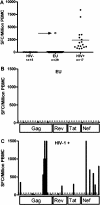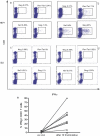Lack of detectable HIV-1-specific CD8(+) T cell responses in Zambian HIV-1-exposed seronegative partners of HIV-1-positive individuals
- PMID: 21288826
- PMCID: PMC3071055
- DOI: 10.1093/infdis/jiq028
Lack of detectable HIV-1-specific CD8(+) T cell responses in Zambian HIV-1-exposed seronegative partners of HIV-1-positive individuals
Abstract
Human immunodeficiency virus type 1 (HIV-1)-specific T cell responses were characterized in a blinded study involving infected individuals and their seronegative exposed uninfected (EU) partners from Lusaka, Zambia. HIV-1-specific T cell responses were detected ex vivo in all infected individuals and amplified, on average, 27-fold following in vitro expansion. In contrast, no HIV-1-specific T cell responses were detected in any of the EU partners ex vivo or following in vitro expansion. These data demonstrate that the detection of HIV-1-specific T cell immunity in EU individuals is not universal and that alternative mechanisms may account for protection in these individuals.
Figures


References
-
- Miyazawa M, Lopalco L, Mazzotta F, Lo Caputo S, Veas F, Clerici M. The ‘immunologic advantage’ of HIV-exposed seronegative individuals. AIDS. 2009;23:161–175. - PubMed
-
- Alimonti JB, Kimani J, Matu L, et al. Characterization of CD8 T-cell responses in HIV-1-exposed seronegative commercial sex workers from Nairobi, Kenya. Immunol Cell Biol. 2006;84:482–485. - PubMed
-
- Makedonas G, Bruneau J, Lin H, Sekaly RP, Lamothe F, Bernard NF. HIV-specific CD8 T-cell activity in uninfected injection drug users is associated with maintenance of seronegativity. AIDS. 2002;16:1595–1602. - PubMed
-
- Hladik F, Desbien A, Lang J, et al. Most highly exposed seronegative men lack HIV-1–specific, IFN-gamma-secreting T cells. J Immunol. 2003;171:2671–2683. - PubMed
Publication types
MeSH terms
Grants and funding
LinkOut - more resources
Full Text Sources
Medical
Research Materials

